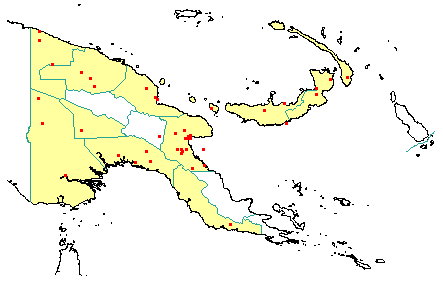
in PNGplants database
PNGTreesKey – Chisocheton lasiocarpus (Miq.) Valeton |
Barry Conn (NSW) & Kipiro Damas (LAE).
Guide to trees of Papua New Guinea
Copyright held by the authors, National Herbarium of New South Wales, and Papua New Guinea National Herbarium
Bulletin Department of Agriculture Ind. Neerl. Vol. 10: 25 (1907)
Other Literature: D.J. Mabberley & A.M. Sing, Flora Malesiana, Series 1 171-174 (1978) Fig. 82.
Family: Meliaceae
Dicotyledon
Timber Group: Commercial hardwood
Field Characters: Large canopy tree; Bole markedly fluted; crooked; buttresses buttresses present (buttresses up to 2 m high); spines spines absent; aerial roots aerial roots absent; stilt roots stilt roots absent; Bark grey or pale brown, rough, slightly pustular, scaly or flaky, or fissured (shallow, vertical), lenticels rounded/swelling (sometimes scattered); Subrhytidome (under-bark) white (cream-coloured); less than 25 mm thick (c. 5 mm thick); bark blaze consisting of one layer; faintly to non-aromatic; outer blaze pale yellow, markings absent, fibrous; inner blaze pale yellow, markings absent, fibrous; bark exudate (sap) absent; terminal buds not enclosed by leaves.
Indumentum: Complex hairs absent; stinging hairs absent; mature twig indumentum (hairs) present or absent, hairs sparse.
Leaves: Leaves spaced along branches, spiral (leaves occurring singly at a node and arranged spirally up the branchlet), compound (a leaf made up from two or more leaflets); petiole present, not winged, attached to base of leaf blade, not swollen; leaves pinnate (unbranched with more than three leaflets); petiolule not swollen; rachis present, absent, present (slightly at base); leaves without a terminal leaflet (the number of leaflets even - paripinnate) (appearing so when terminal leaflet damaged) or with a terminal leaflet (the number of leaflets odd - imparipinnate), equally broad throughout much of length, (6.0-) 12.0-44.0 cm, (3.0-) 6.0-16.0 (-23.0) cm, leaflets opposite, symmetric, terminal developing leaflet buds curled back on itself; venation pinnate, secondary veins open, prominent, intramarginal veins absent; leaves lower surface green, upper surface dark green, indumentum (hairs) absent; absent; domatia absent; stipules absent.
Flowers: Inflorescence axillary, flowers on a branched axis, cones absent; flowers bisexual, stalked, flowers with many planes of symmetry, 10.0-15.0 mm long, diameter small (up to10 mm diam.) (6-8 mm diam.); perianth present, with distinct sepals and petals whorls (sepals reduced to collar), inner perianth white or pink (pale tinge); 5, free; stamens 5, absent, joined (staminal column), free of the perianth; ovary superior, carpels joined (when more than one), locules (3-) 4-5 (-6); styles solitary, 1.
Fruits: Infrutescence arranged on branched axis, fruit 40.0-80.0 mm long, 40.0-70.0 mm diam., red or brown, not spiny, slightly fleshy, simple, indehiscent, berry; seeds 3, much more than 10 mm long (c. 50 mm long), not winged, narrow (longer than wide), seed 1-10 mm diam. (c. 3 mm diam.).
Distribution: West Sepik, East Sepik, Madang, Morobe, Southern Highlands, Western, Gulf, Central, New Britain & New Ireland.
 | Botanical records in PNGplants database |
Notes: Notes This species consists of a complex of morphological forms that may be quite common in any particular locality. Mabberley and Sing (1995) Flora Malesiana Series 1, Volume 12, pp 152-156 included the following previously recognised Papua New Guinean species into this broad species concept: Chisocheton caroli Harms, C. formicarum Harms, C. novoguineensis C.DC., C. pachyrhachis Harms, C. schlechteri Harms, C. schumannii Harms, C. trichocladus Harms, C. versteegii C.DC., and C. weinlandii Harms.